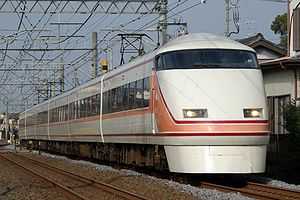Tobu 100 series
| Tobu 100 series | |
|---|---|
 100 series in original livery, November 2007 | |
| In service | June 1990 – |
| Manufacturer | Alna Kōki, Tokyu Car Corporation |
| Replaced | 1720 series |
| Constructed | 1989–1991 |
| Refurbishment | 2011–2012 |
| Number built | 54 vehicles (9 sets) |
| Number in service | 54 vehicles (9 sets) |
| Formation | 6 cars per trainset |
| Operator | Tobu Railway |
| Depot(s) | Kasukabe |
| Line(s) served | Tobu Skytree Line, Tobu Nikko Line, Tobu Kinugawa Line, Tōhoku Main Line |
| Specifications | |
| Car body construction | Aluminium[1] |
| Car length | 20 m (65 ft 7 in) |
| Doors | One per side |
| Electric system(s) | 1,500 V DC |
| Current collection method | Overhead line |
| Safety system(s) | Tobu ATS, ATS-P (three sets) |
| Track gauge | 1,067 mm (3 ft 6 in) |
The Tobu 100 series (東武100系 Tōbu 100-kei), branded Spacia (スペーシア), is a limited express electric multiple unit (EMU) train type operated by the Tobu Railway in Japan since 1990. The trains are used on Kegon and Kinu services to Nikkō and Kinugawa-Onsen.[2]
Formation
As of 1 April 2012, the fleet consists of nine sets, based at Kasukabe Depot, and formed as follows.[1]
| Car No. | 1 | 2 | 3 | 4 | 5 | 6 |
|---|---|---|---|---|---|---|
| Designation | Mc2 | M4 | M3 | M2 | M1 | Mc1 |
| Numbering | 100-6 | 100-5 | 100-4 | 100-3 | 100-2 | 100-1 |
Interior
Seat pitch is 1,100 mm (43 in). Car 6 contains six 4-seat compartments. These are marked as "Green cars" when operating on JR lines.[3]
-
Interior view
-
Reclining seats
-
4-seat compartment in Car 6
History
The 100 series trains entered service on 1 June 1990 on Kegon and Kinu services from Asakusa in Tokyo to Nikkō and Kinugawa-Onsen, replacing the ageing 1720 series trains operating since 1960. Two sets were delivered in fiscal 1989, two more were delivered in fiscal 1990, and five were delivered in fiscal 1991, bringing the fleet to nine sets.[3]
All cars were made no-smoking from 18 March 1995.[1]
JR inter-running
Through-running Spacia Nikkō and Spacia Kinugawa services from Shinjuku in Tokyo to Tōbu Nikkō and Kinugawa-Onsen via the JR Tōhoku Main Line commenced on 18 March 2006, and three sets (106 to 108) were modified with JR ATS-P for use on JR East lines.[3]
Refurbishment
The fleet underwent a programme of refurbishment from December 2011, ahead of the opening of the Tokyo Skytree in May 2012. Three trains each were repainted into three different colour schemes, with "miyabi" purple, "iki" light blue, and "sunny coral orange", matching the Tokyo Skytree theme colours, and new "Spacia" logos. Internally, the seats feature new moquette, with blue in the open saloons and brown in the compartments.[4] The first refurbished set re-entered service from 29 December 2011.[5]
| Set No. | Colour scheme | Date refurbished |
|---|---|---|
| 101 | B: "iki" blue | 29 June 2012[6] |
| 102 | A: "miyabi" purple | 28 March 2012[7] |
| 103 | C: "sunny coral" orange | 2 March 2012[7] |
| 104 | C: "sunny coral" orange | 28 September 2012[8] |
| 105 | A: "miyabi" purple | 28 December 2011[7] |
| 106 | C: "sunny coral" orange | 25 July 2012[8] |
| 107 | A: "miyabi" purple | 31 May 2012[6] |
| 108 | B: "iki" blue | 27 April 2012[6] |
| 109 | B: "iki" blue | 3 February 2012[7] |
-

First refurbished set, 105, in "miyabi" purple livery, December 2011
-

Refurbished set 109 in "iki" blue livery, February 2012
-

Refurbished set 103 in "sunny coral" orange livery, March 2012
References
- ↑ 1.0 1.1 1.2 私鉄車両編成表 2012 [Private Railway Rolling Stock Formations - 2012]. Japan: JRR. July 2012. p. 45. ISBN 978-4-330-29911-2.
- ↑ 日本と世界の鉄道カタログ [Japan and World Railway Catalogue]. Japan: Seibido Publishing. July 1992. ISBN 4-415-03262-1.
- ↑ 3.0 3.1 3.2 "2006東武鉄道優等車両カタログ" [2006 Tōbu Railway Express Rolling Stock Catalogue]. Tetsudō Daiya Jōhō Magazine (Japan: Kōtsū Shimbun) 35 (264): p18–21. April 2006.
- ↑ "東武鉄道100系”スペーシア”リニュアル車" [Refurbished Tobu 100 series "Spacia" sets]. Tetsudō Daiya Jōhō Magazine (Japan: Kōtsū Shimbun) 41 (335): p.70. March 2012.
- ↑ "特急スペーシアをリニューアルします!!" [Spacia limited express to be refurbished] (pdf). News Release (in Japanese). Japan: Tobu Railway. 15 December 2011. Retrieved 16 December 2011.
- ↑ 6.0 6.1 6.2 "私鉄車両のうごき" [Private Rail Rolling Stock Changes]. Tetsudō Daiya Jōhō Magazine (Japan: Kōtsū Shimbun) 41 (342): p.124. October 2012.
- ↑ 7.0 7.1 7.2 7.3 "私鉄車両のうごき" [Private Rail Rolling Stock Changes]. Tetsudō Daiya Jōhō Magazine (Japan: Kōtsū Shimbun) 41 (339): p.125. July 2012.
- ↑ 8.0 8.1 "私鉄車両のうごき" [Private Rail Rolling Stock Changes]. Tetsudō Daiya Jōhō Magazine (Japan: Kōtsū Shimbun) 42 (345): p.125. January 2013.
External links
| Wikimedia Commons has media related to Tobu 100 series. |
- Tobu 100 series information (Japanese)
| |||||||||||||


